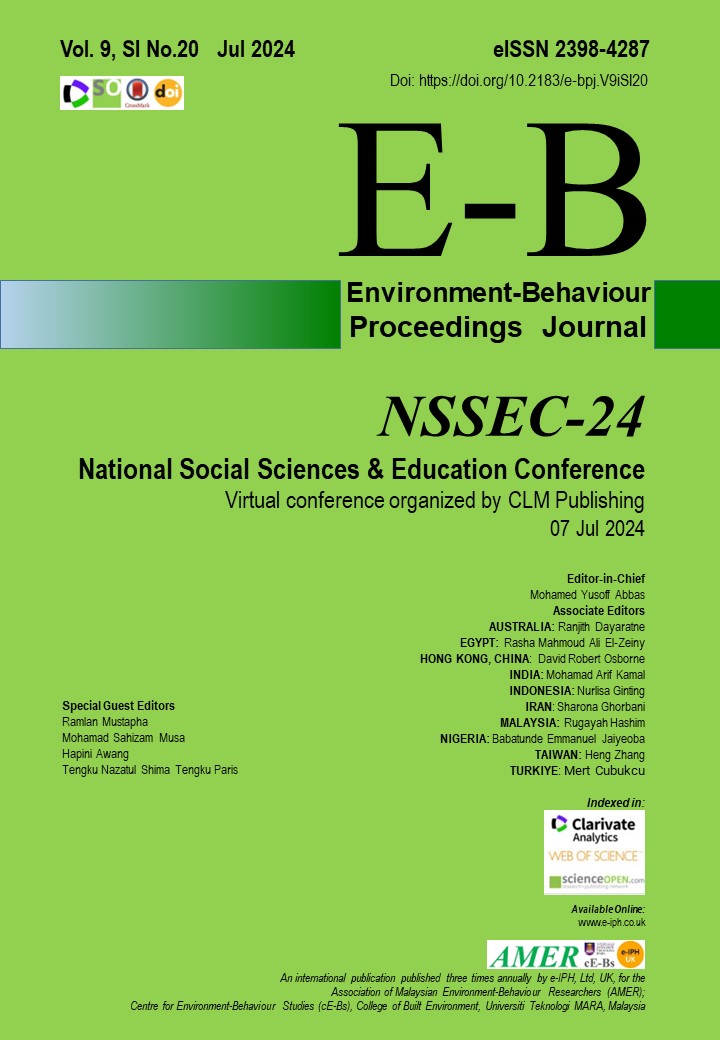Fostering Innovative Work Behaviour of Public Sector Employees: A Nominal Group Technique
DOI:
https://doi.org/10.21834/e-bpj.v9iSI20.6103Keywords:
Innovative Work Behaviour, Public Sector, Nominal Group Technique, Human Resource ManagementAbstract
Innovative work behaviour has received significant attention in research that benefits individuals, groups and organisations. However, factors that affect innovative work behaviour, specifically among public sector employees, are rarely studied. Hence, this paper proposes solutions to increase innovative work behaviour using the Nominal Group Technique (NGT). The experts provided an overview of 11 potential solutions to enhance the public sector employee's innovative work behaviour. The NGT approach facilitated the quick and readily validation of literature elements that experts subsequently discussed and voted on. This paper references future studies on human resource management and practices.
References
Abdullah, M. M., & Islam, R. (2011). Nominal Group Technique and its Applications in Managing Quality in Higher Education. Pak. J. Commer, Scocial Science, 5(1), 81–99.
Afsar, B., Al-Ghazali, B. M., Cheema, S., & Javed, F. (2020). Cultural intelligence and innovative work behavior: the role of work engagement and interpersonal trust. European Journal of Innovation Management, 24(4), 1082–1109. https://doi.org/10.1108/EJIM-01-2020-0008 DOI: https://doi.org/10.1108/EJIM-01-2020-0008
Al-Omari, M. A., Choo, L. S., & Ali, M. A. M. (2019). Innovative work behavior: A review of literature. International Journal of Psychosocial Rehabilitation, 23(2), 39–47. https://doi.org/10.37200/IJPR/V23I2/PR190268
AlEssa, H. S., & Durugbo, C. M. (2022). Systematic review of innovative work behavior concepts and contributions. In Management Review Quarterly (Vol. 72, Issue 4). Springer International Publishing. https://doi.org/10.1007/s11301-021-00224-x DOI: https://doi.org/10.1007/s11301-021-00224-x
Alheet, A. F., Adwan, A. Al, Areiqat, A. Y., Zamil, A. M. A., & Saleh, M. A. (2021). The effect of leadership styles on employees' innovative work behavior. Management Science Letters, 11, 239–246. https://doi.org/10.5267/j.msl.2020.8.010 DOI: https://doi.org/10.5267/j.msl.2020.8.010
Bos-Nehles, A., Renkema, M., & Janssen, M. (2017). HRM and innovative work behaviour: a systematic literature review. In Personnel Review (Vol. 46, Issue 7, pp. 1228–1253). Emerald Group Publishing Ltd. https://doi.org/10.1108/PR-09-2016-0257 DOI: https://doi.org/10.1108/PR-09-2016-0257
Carlucci, D., Mura, M., & Schiuma, G. (2020). Fostering Employees' Innovative Work Behaviour in Healthcare Organisations. International Journal of Innovation Management, 24(2). https://doi.org/10.1142/S1363919620500140 DOI: https://doi.org/10.1142/S1363919620500140
Choi, W. S., Kang, S. W., & Choi, S. B. (2021). Innovative behavior in the workplace: an empirical study of moderated mediation model of self-efficacy, perceived organisational support, and leader–member exchange. Behavioral Sciences, 11(12). https://doi.org/10.3390/bs11120182 DOI: https://doi.org/10.3390/bs11120182
Contreras, F., Juarez, F., Cuero Acosta, Y. A., Dornberger, U., Soria-Barreto, K., Corrales-Estrada, M., Ramos-Garza, C., Steizel, S., Portalanza, A., Jauregui, K., Iwashita da Silva, L., & Yshikawa Salusse, M. A. (2020). Critical factors for innovative work behaviour in Latin American firms: Test of an exploratory model. Cogent Business and Management, 7(1). https://doi.org/10.1080/23311975.2020.1812926 DOI: https://doi.org/10.1080/23311975.2020.1812926
De Jong, J., & Den Hartog, D. (2010). Measuring innovative work behaviour. Creativity and Innovation Management, 19(1), 23–36. https://doi.org/10.1111/j.1467-8691.2010.00547.x DOI: https://doi.org/10.1111/j.1467-8691.2010.00547.x
De Spiegelaere, S. (2014). The Employment Relationship and Innovative Work Behaviour. Thesis, September. https://doi.org/10.13140/2.1.3347.9047
Dorenbosch, L., Engen, M. L. va., & Verhagen, M. (2005). On-the-job innovation: The impact of job design and human resource management through production ownership. Creativity and Innovation Management, 14(2), 129–141. https://doi.org/10.1111/j.1476-8691.2005.00333.x DOI: https://doi.org/10.1111/j.1476-8691.2005.00333.x
Farrukh, M., Meng, F., Raza, A., & Wu, Y. (2022). Innovative work behaviour: the what, where, who, how and when. Personnel Review. https://doi.org/10.1108/PR-11-2020-0854 DOI: https://doi.org/10.1108/PR-11-2020-0854
Farr, J. L., & Ford, C. M. (1990). Individual innovation. In M. A. West & J. L. Farr (Eds.), innovation and creativity at work: Psychological and organisational strategies (pp. 63–80). John Wiley & Sons.
Janssen, O. (2000). Job demands, perceptions of effort-reward fairness and innovative work behavior. Journal of Occupational and Organizational Psychology, 287–302. DOI: https://doi.org/10.1348/096317900167038
King, Nigel , Anderson, Neil. (2002). Managing innovation and change: a critical guide for organisations . London: Thomson.
Mansoor, A., Farrukh, M., Wu, Y., & Abdul Wahab, S. (2021). Does inclusive leadership incite innovative work behavior. Human Systems Management, 40(1), 93–102. https://doi.org/10.3233/HSM-200972 DOI: https://doi.org/10.3233/HSM-200972
Muqsith Ahmad, A., Hussin, Z., Yusof Fakulti Kejuruteraan, F., Ridhuan Mohd Jamil Jabatan Kejuruteraan Mekanikal, M., & Nilai, P. (2017). Nominal Group Technique (NGT) Dan Aplikasinya Terhadap Pembinaan Elemen Etika Dan Nilai (Akhlak) Berasaskan Aktiviti Inkuiri 125 Politeknik &. Kolej Komuniti Journal of Social Sciences and Humanities, 1, 128–2875.
Mustapha, R., Ibrahim, N., Mahmud, M., Jaafar, A. B., Wan Ahmad, W. A., & Mohamad, N. H. (2022). Brainstorming the Students Mental Health after Covid-19 Outbreak and How to Curb from Islamic Perspectives: Nominal Group Technique Analysis Approach. International Journal of Academic Research in Business and Social Sciences, 12(2). https://doi.org/10.6007/ijarbss/v12-i2/12367 DOI: https://doi.org/10.6007/IJARBSS/v12-i2/12367
Scott, S. G., Bruce, R. A., Scott, S. G., & Bruce, R. A. (1994). The birth of a century: early color photographs of America. Choice Reviews Online, 32(03), 32-1325-32–1325. https://doi.org/10.5860/choice.32-1325 DOI: https://doi.org/10.5860/CHOICE.32-1325
Siti Farhah A. A. & Saedah S. (2015). Pembangunan Model Objektif Kurikulum Berasaskan Taman Buah-Buahan Dan Sayur-Sayuran Berkhasiat Untuk Sekolah Rendah Orang Asli. Jurnal Kurikulum dan Pengajaran Asia Pasifik. Bil 3 Isu 3. 1-13.
Stankevičiute, Ž., Staniškiene, E., & Cigane, U. (2020). Sustainable HRM as a driver for innovative work behaviour: Do respect, openness, and continuity matter? the case of lithuania. Sustainability (Switzerland). https://doi.org/10.3390/SU12145511 DOI: https://doi.org/10.3390/su12145511
Van De, A., & Delbecq, A. L. (1971). Nominal Versus Interacting Group Processes for Committee Decision-Making Effectiveness. Academy of Management Journal, 14(2), 203–212. https://doi.org/10.5465/255307 DOI: https://doi.org/10.5465/255307
Ven, A. H. Van de. (1986). Central Problems In The Management of Innovation. Management Science, 32(5), 590–607. DOI: https://doi.org/10.1287/mnsc.32.5.590
Xerri, M. J., & Brunetto, Y. (2013). Fostering innovative behaviour: The importance of employee commitment and organisational citizenship behaviour. International Journal of Human Resource Management, 24(16), 3163–3177. https://doi.org/10.1080/09585192.2013.775033 DOI: https://doi.org/10.1080/09585192.2013.775033
Downloads
Published
How to Cite
Issue
Section
License
Copyright (c) 2024 Hafsah Abdul Aziz, Kalsom Ali

This work is licensed under a Creative Commons Attribution-NonCommercial-NoDerivatives 4.0 International License.





